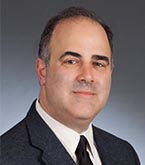XTRACT as a Potential Frontline Treatment in Peripheral Arterial Thromboembolism: Results from the PRISM Trial
Abstract title: XTRACT as a Potential Frontline Treatment in Peripheral Arterial Thromboembolism: Results from the PRISM Trial
Abstract authors: R. Saxon, J. F. Benenati, C. Teigen, L. Sewall, G. L. Adams
Interview with Richard Saxon, MD:
 What sets your study apart from what is already in the literature?
What sets your study apart from what is already in the literature?
Dr. Saxon: When compared with research on the treatment of critical limb ischemia, there is relatively little research being done on the endovascular treatment of acute and subacute limb ischemia caused by arterial thromboembolism. PRISM, the first attempt at a multicenter, objective evaluation of the XTRACT technique, used the Penumbra/Indigo system for mechanical vacuum-assisted aspiration embolectomy in the treatment of a wide variety of clinical situations involving acute peripheral arterial occlusions.
Can you briefly describe your findings?
Dr. Saxon: A total of 79 patients were enrolled: 39 (49.4%) underwent XTRACT as the initial therapy, and 40 (50.6%) underwent XTRACT after failed catheter-directed thrombolysis or other mechanical intervention, or for removal of distal emboli that occurred during an intervention. Complete or near-complete revascularization (Thrombolysis in Myocardial Infarction [TIMI] grade 2/3 flow) was achieved in 87.2% of patients (68 of 78) immediately after the XTRACT procedure and before any other intervention. Successful revascularization was achieved in 79.5% of patients (31 of 39) as an initial treatment and in 92.5% (37 of 40) as salvage or secondary therapy. Normal flow (TIMI grade 3) was achieved in 77.2% of patients (61 of 79) without any device-related complications. We concluded that XTRACT was safe and effective for revascularization of acute or subacute peripheral arterial occlusions as a primary therapy or as a secondary therapy after other endovascular techniques had failed.
Tell me about something surprising you encountered while doing this research.
Dr. Saxon: It was surprising to me that XTRACT could work as well as it did after other techniques, such as CDT, had failed. It was not always effective, but it was relatively quick, simple to perform, and helpful.
How might your findings affect clinical practice?
Dr. Saxon: I think the PRISM study confirms that aspiration thromboembolectomy has a role in a number of difficult clinical situations and adds another tool to the interventionalist’s “tool box” that should be considered when dealing with emboli or acute to subacute arterial thrombosis.
What future studies would you like to see take place?
Dr. Saxon: Using a modified TIMI score pre- and post-use of XTRACT and before any other interventions provided an objective assessment of how well the Penumbra/Indigo system worked. I would like to see this approach universally adopted in future studies assessing these types of technologies.
Although PRISM helped confirm the acute safety and technical success of XTRACT, long-term clinical outcomes in the setting of acute limb ischemia were not assessed. It would be helpful to have future studies assess the limb salvage efficacy of XTRACT as a component of an “endovascular-first” approach to the treatment of acute limb ischemia.
Finally, more research needs to be done on the use of larger devices (8 Fr and above) in the setting of substantial clot burden in larger arteries, such as the iliac and common femoral artery, in which XTRACT will likely be more difficult to perform. These situations were successfully treated in PRISM, but only in a small number of patients.
What are you hoping that attendees take away from your presentation?
Dr. Saxon: I would like to have attendees leave with the understanding that aspiration embolectomy can be added to surgical embolectomy and catheter-directed thrombolysis as a helpful tool in the treatment of acute limb ischemia. It is safe and quick to perform in a variety of difficult clinical situations, such as the removal of organized atheroemboli that occur during an endovascular procedure, or as an alternative to catheter-directed thrombolysis in patients who cannot receive thrombolytic therapy.













